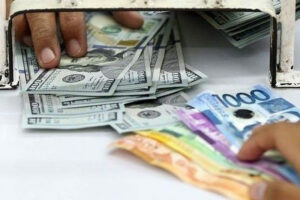Stronger peso likely to hurt exports, services
THE PESO could strengthen further following the start of the US Federal Reserve’s rate-cutting cycle, analysts said, but warned that these could impact exports and services.

By Luisa Maria Jacinta C. Jocson, Reporter
THE PESO could strengthen further following the start of the US Federal Reserve’s rate-cutting cycle, analysts said, but warned that these could impact exports and services.
“Philippine markets will be closely monitoring the potential impact of the US Federal Reserve rate cut on the domestic economy,” Security Bank Corp. Chief Economist Robert Dan J. Roces said in a Viber message.
“A stronger peso, which could result from the move, could negatively affect exports and other entities such as business process outsourcing companies (BPOs), but positively influence domestic prices,” he added.
This after the Fed delivered a 50-basis-point (bp) rate cut last week and amid expectations of further easing by the US central bank throughout this year and the next.
Markets imply nearly a 49% chance the Fed will deliver another 50-bp rate cut in November and have priced in 75 bps of cuts by the end of this year, Reuters reported.
The Fed’s policy rate is expected by the end of 2025 to be at 2.85%, which is now thought to be the Fed’s estimate of the neutral rate.
“The bigger accommodation in the US policy rate on balance reduces the certainty of the possible capital outflow should the interest rate spread move against the peso,” Diwa C. Guinigundo, a country analyst for the Philippines of GlobalSource Partners, said.
“If we manage to get all macroeconomic indicators going in the right direction, there’s a good chance the peso will remain more stable with a strengthening bias,” he added.
The peso closed at P55.97 against the greenback on Monday, depreciating by 28 centavos from its P55.69 finish on Friday, Bankers Association of the Philippines data showed.
The local currency previously fell to as low as the P58-per-dollar level in May and hit a 20-month low of P58.86 on June 26.
Metropolitan Bank & Trust Co. (Metrobank) Research in a commentary expects the peso to close at P55.30 per dollar by yearend, stronger than its earlier forecast of P57.20.
It also sees the local unit closing at P54.50 in 2025 from P56.30 previously.
“These forecasts also take into consideration the expected net dollar inflows from remittances in the fourth quarter, which would be partially offset by a projected wider trade deficit,” Metrobank Research added.
However, Pantheon Macroeconomics Chief Emerging Asia Economist Miguel Chanco noted there is still a need to be cautious about the peso’s performance for the rest of the year.
“Regardless of what the Fed does, and despite the peso’s upward retracement over the past few weeks, I’m still somewhat cautious on the peso’s outlook given the economy’s twin deficits on the current and fiscal accounts,” he said in an e-mail.
The current account deficit stood at $7.1 billion in the first half of the year, equivalent to -3.2% of GDP. The BSP expects the current account deficit to reach $6.8 billion this year (-1.5% of GDP).
The central bank last week trimmed its projections for goods and services exports this year. It now sees good exports growing by 4% this year from 5% previously, while services exports are seen expanding by 13% from 14% previously.
Meanwhile, latest data from the Treasury showed that the budget deficit widened by 7.21% to P642.8 billion in the first seven months of the year.
“All up, the peso will surely act up, but nobody knows in which direction because it cannot be delinked from other counterweights like better inflation and growth outcomes, the quality of public policy, the resolution of those political conflicts,” Mr. Guinigundo added.
FURTHER EASING
The Fed’s highly anticipated rate cut last week also gives the Bangko Sentral ng Pilipinas (BSP) more room to possibly deliver bigger rate reductions, analysts said.
“The first — faster and more ambitious than expected — start to its easing cycle will certainly give the BSP a lot more room to pursue more aggressive rate cuts in the coming meetings,” Mr. Chanco said.
BSP Governor Eli M. Remolona, Jr. earlier said that they could cut by another 25 bps in the fourth quarter. This after the central bank reduced borrowing costs by 25 bps at its August meeting, bringing the key rate to 6.25%.
The Monetary Board’s next meeting is on Oct. 17 while its last meeting for the year is scheduled for Dec. 19.
“Indeed, our base case before the Fed’s decision is that the Board will step up the size of its rate cuts to 50 bps each time from December, as we’ve long held a view that the Fed would pursue equally large cuts from the fourth quarter,” Mr. Chanco said.
Meanwhile, Metrobank Research expects the BSP to cut by a total of 75 bps this year, bringing the key rate to 5.75% by yearend.
“On the domestic front, the Fed move opens the door for a 25-bp cut in October by the BSP,” it said.
The central bank could reduce rates by 25 bps each at its last two meetings this year, Metrobank added.
“This would bring the BSP’s target reverse repurchase (RRP) rate down to 5.75% by year-end. The interest rate differential between the BSP and the US Fed would settle at 125 bps.”
“Previously, (Mr.) Remolona signaled a modest 50 bps of cumulative cuts for the year. A BSP pause in October suggests the BSP would only get a chance to adjust policy rates after two more projected Fed rate cuts,” it added.
For next year, Metrobank Research expects the BSP to cut by a total of 100 bps. This would bring the benchmark rate to 4.75%.
Mr. Chanco also noted Mr. Remolona’s repeated signals of the BSP being independent of the Fed.
“Most central banks in the region (not just in the Philippines) tend to only fret about Fed action when rates are going the other way around (i.e. up), given that this normally exerts a lot of downside pressure on regional currencies,” he added.
















